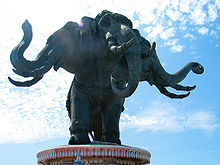Lucy (building)
Lucy is a structure in the shape of an elephant in Margate City in Atlantic County , New Jersey , USA . It is the second largest representation of an elephant in the world after the glass elephant in Hamm , Germany and a National Historic Landmark .
history
Lucy , named Elephant Bazaar until 1900 , was built in 1881 by James V. Lafferty . The aim of the unusual building was to draw tourists from Atlantic City to Margate. The wooden structure on the corner of Atlantic and South Decatur Avenues is six stories high and can be seen with the naked eye from eight miles away. The building was considered so unusual at the time it was built that Lafferty was granted a patent that granted him the right to erect animal-shaped buildings for seventeen years.
He took advantage of this privilege by first building the Elephantine Colossus , also known as the Elephant Hotel , on Coney Island . The Elephantine Colossus was about twice the size of Lucy. One of his feet contained a cigar shop, hotel rooms were housed in the trunk and there was a viewing platform on the back. But the Elephantine Colossus was destroyed in a fire in 1896.
In 1884, the year of the White Elephant War , Lafferty built The Light of Asia , another elephant-shaped building. It was in Cape May , New Jersey, and was demolished before the turn of the century.
By the 1960s, Lucy was left to decay. In 1969 the Save Lucy Committee was formed around Edwin T. Carpenter. This group managed to restore Lucy and rebuild it in a new location. In May 1976, Lucy was granted National Historic Landmark status .
use
Lucy has been used differently over the years. It served as an official building and office, but also as a restaurant and pub, which was closed during the Prohibition period . In 1902 it was rented to an English family who used it as a kind of bathing cabin.
Today it can be visited; you can get inside via a spiral staircase in one of its rear legs. There you can see exhibits on the history of the building. The observation deck on top of the building offers a view of the Atlantic.
Others

Lafferty wasn't the first person to come up with the idea of building a walk-in elephant. As early as the 18th century, the French Charles Ribart planned the construction of an éléphant triomphal on the spot where the Arc de Triomphe stands today. The éléphant triomphal would have been entered via a staircase under the belly and would have contained several rooms. Wastewater would have been disposed of through the trunk. Unlike Lafferty's three elephant constructions, the éléphant triomphal would not have carried an open Houda on its back. Ribart's plans were rejected and the project never materialized.
Animal-shaped buildings are sometimes erected to accommodate museums and similar institutions. In Knie's children's zoo in Rapperswil, for example, there is a walk-in whale that houses the zoo's aquariums. The Universum Bremen is also reminiscent of a whale or a giant clam.
The Erawan Museum in Samut Prakan in Thailand is crowned by a walk-in, 39-meter-long mythical three-headed stone elephant. In the Maximilianpark in Hamm there is a sculpture called " Glass Elephant " with an elevator and viewing platform.
See also
Web links
Remarks
- ↑ Listing of National Historic Landmarks by State: New Jersey. National Park Service , accessed August 17, 2019.





